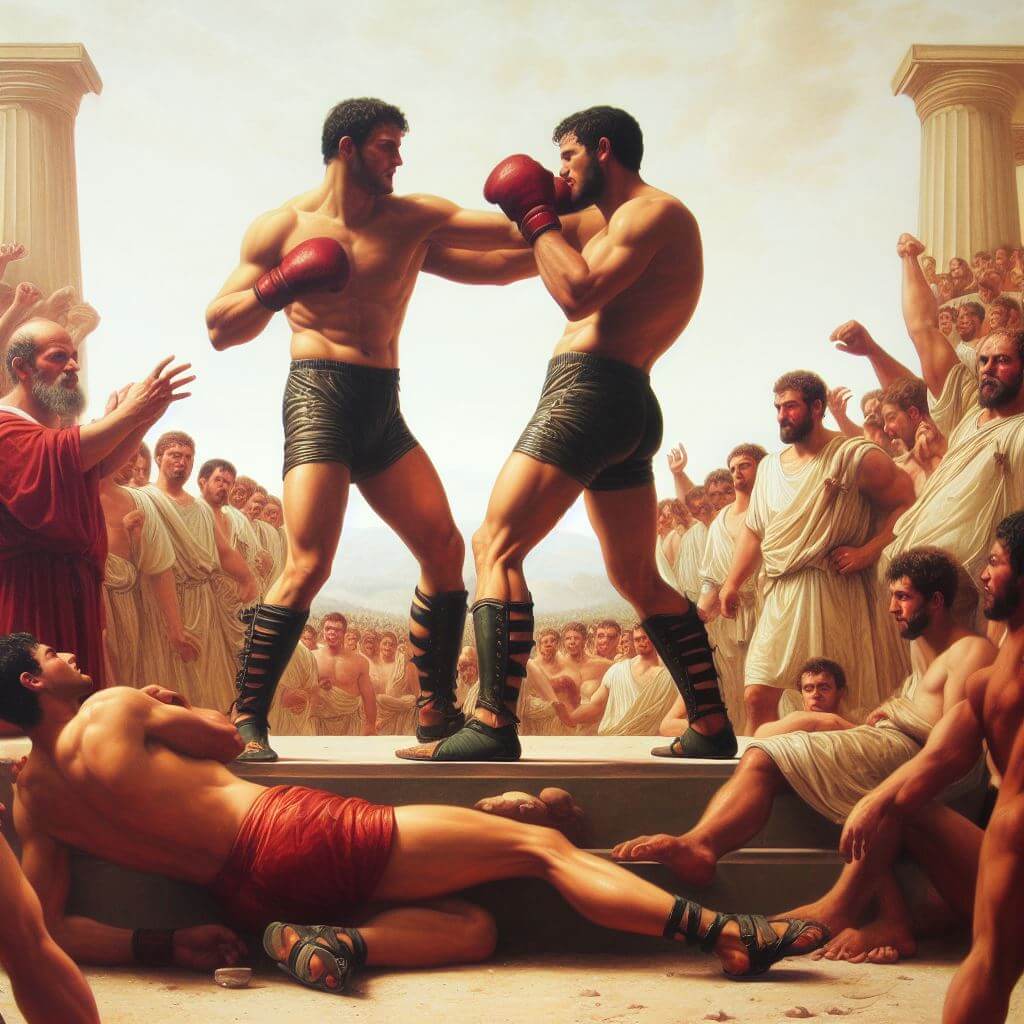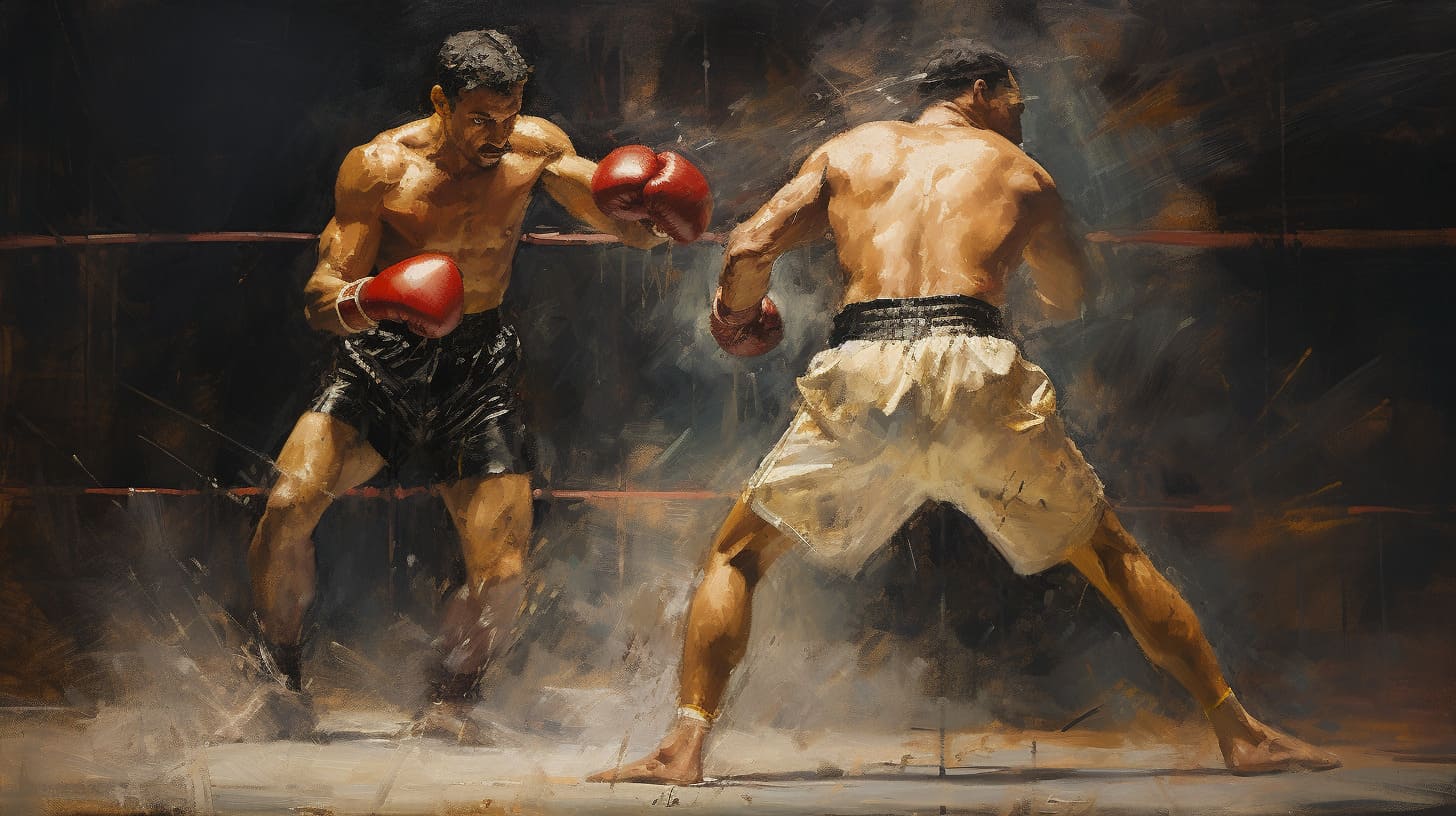Boxing is much more than a sport; it’s a history with stories of triumph, evolution, and an enduring human spirit. From its ancient origins to its modern-day manifestations, boxing sport history has continuously adapted, showcasing a rich history filled with notable milestones. This article delves into the captivating journey of boxing from ancient rings to modern gloves, exploring how it has evolved over centuries to become the beloved sport we know today.
Boxing’s history Beginnings

boxing sport history – ancient boxing
The sport of boxing has a long and storied history, dating back to ancient times when competitions of strength and skill were held in honor of the gods. The earliest known representations of boxing are found in Sumerian carvings from the 3rd millennium BC, showcasing the sport’s deep-rooted origins.
- Sumerian Beginnings: Boxing’s roots can be traced back to Sumerian civilization, where ancient carvings depict men engaging in fistfights. These ancient boxers fought with wrapped fists, a practice that evolved over centuries.
- Olympic Glory: The sport found its way to ancient Greece, where it was introduced as an Olympic sport in the 23rd Olympiad in 688 B.C., making it one of the earliest sports to be included in the prestigious games.
- Roman Spectacles: In ancient Rome, boxing was part of the gladiatorial spectacles, showcasing a more brutal version of the sport where fighters often fought to the death.
| Aspect | Description |
|---|---|
| Origin | Sumerian civilization, 3rd millennium BC |
| Olympic Inclusion | 23rd Olympiad, 688 B.C. |
| Roman Era | Gladiatorial spectacle |
Boxing in ancient times was a test of endurance, strength, and courage. Fighters competed until one was unable to continue, emphasizing the harsh and brutal nature of early boxing. Despite its ferocity, boxing was a revered sport, celebrated for its demonstration of human strength and determination.
The traditional boxing stance we’re familiar with today also has its roots in ancient times. The lead leg slightly forward with the lead hand semi-extended as a guard, and the dominant hand drawn back ready to strike – this classic boxing stance has stood the test of time, tracing back to ancient Greek boxers.
Transitioning from ancient to more recent times, boxing’s history is marked by significant evolution, particularly in 16th to 18th century England where the sport resurfaced with a new identity.
Ancient Greek Boxing

ancient greek boxing
Ancient Greece holds a significant place in the history of boxing. The sport was not only popular but also considered an integral part of Greek culture. In fact, boxing was included in the first Olympic Games held in 776 BC. However, unlike the modern concept of boxing with rounds, ancient Greek boxing contests had no rounds and continued until one participant was unable to continue.
Ancient Greek boxing was a dangerous sport, often resulting in severe injuries or even death. Fighters would wrap their hands in leather straps called “himantes” to protect their knuckles and inflict more damage on their opponents. The lack of protective gear and the absence of rounds made these matches intense and brutal.
The significance of boxing in ancient Greek culture extended beyond mere sport. It was believed that boxing had connections to mythology, with the legendary heroes Hercules and Theseus being celebrated as skilled boxers. The sport was seen as a test of strength and character, embodying the ideals of Greek society.
| Ancient Greek Boxing | Ancient Roman Boxing |
|---|---|
| No rounds, continued until one participant was unable to continue | Part of larger spectacles, including gladiatorial combat |
| Fighters wrapped their hands in leather straps called “himantes” | Introduced the caestus, a glove made of leather with metal or spikes |
| Matches were intense and brutal | Matches were often part of larger spectacles and attracted large crowds |
| Boxing had connections to mythology | Declined in popularity with the fall of the Roman Empire and the rise of Christianity |
Bare-Knuckled Boxing in 16th to 18th Century England

bare knuckle boxing
As the tides of time swept across the shores of history, boxing resurfaced in England during the 16th century with a form known as bare-knuckle boxing. This era saw the sport evolve from a brutal spectacle to a more organized competition with established rules.
- Emergence of Bare-Knuckle Boxing: The first documented bare-knuckle bout occurred in London in 1681, marking the beginning of a new era in boxing. The sport was raw, brutal, yet held a certain allure that captivated the hearts of many.
- Broughton’s Ruleset: Jack Broughton, a champion of this era, introduced a ruleset in 1743 to protect the fighters, laying down the foundation for modern boxing rules. His foresight led to a much-needed reform in the sport, emphasizing the importance of safety alongside competition.
- Prizefighting Era: Fighters, known as prizefighters, competed for money, bringing a professional aspect to the sport. The allure of prize money brought many aspirants to the ring, further popularizing boxing.
Explore the Rules of Boxing1
Key Takeaways
- Bare-Knuckle Era: Emergence in 16th century England, first documented bout in London, 1681.
- Broughton’s Ruleset: Introduction in 1743, foundation for modern boxing rules.
- Prizefighting: Professional aspect of boxing emerges.
The bare-knuckle era was a time of raw competition and fierce rivalries. It was during this time that the term “boxing” began to be used, and the sport started to garner a following. The introduction of rules by Jack Broughton was a significant milestone, as it marked a shift towards a more organized and safer form of competition. The prizefighting era further propelled boxing into the limelight, laying the groundwork for the professional sport we know today.
As boxing transitioned into the 19th century, it was about to undergo a revolutionary transformation that would forever change the face of the sport, ushering in an era of gloved boxing that continues to this day.
19th Century to Modern Boxing

19th century boxing
The 19th century witnessed a revolutionary change in boxing with the introduction of the Marquess of Queensberry Rules. This new set of regulations brought in boxing gloves, changing the face of the sport forever.
- Marquess of Queensberry Rules: Established in the mid-1800s, these rules introduced gloves, three-minute rounds, and a more humane approach to boxing. The implementation of these rules marked a significant evolution, making boxing a safer and more strategic sport.
- Global Popularity: Boxing’s popularity soared worldwide, with countries like the United States, Mexico, and Russia embracing the sport. The universal appeal of boxing bridged cultural and geographical divides, establishing it as a truly global sport.
- Modern Training Techniques: Modern boxing saw the introduction of scientific training techniques and strategies, enhancing the sport’s competitive nature. The fusion of traditional boxing techniques with modern training methodologies has propelled boxing into a new era of excellence.
Training and Techniques2 | Equipment and Gear3
| Aspect | Description |
|---|---|
| Queensberry Rules | Introduction, Impact on the sport |
| Gloves | Safety and strategy alteration |
| Modern Popularity | Global acceptance, Professional boxing |
The gloved revolution brought a new level of sophistication and safety to boxing. The Marquess of Queensberry Rules were instrumental in shaping the modern sport, introducing elements that made boxing more appealing to a wider audience. The global popularity of boxing is a testament to the sport’s enduring appeal and its ability to adapt to the changing tides of time.
Through the lens of history, we see a sport that has continuously evolved, growing from ancient roots to become a modern-day phenomenon. The exploration of boxing’s history is a journey through time, showcasing the indomitable human spirit and the love for competition that has propelled boxing forward through the ages.
Conclusion
The journey of boxing from ancient rings to modern gloves encapsulates a fascinating traverse through time. With each punch thrown, every bout fought, boxing has etched its tale into the annals of history, reflecting the evolving narrative of human competition and spirit.
- Historical Milestones: From the bare-knuckle brawls of 16th century England to the gloved boxing of the modern era, the sport has witnessed significant milestones that have contributed to its rich historical tapestry.
- Enduring Legacy: Boxing’s enduring legacy is a testament to its timeless appeal. Through centuries, it has remained a beloved sport, continuously adapting to the changing societal norms and preferences.
- Global Phenomenon: The global popularity of boxing underscores its universal appeal. Regardless of cultural or geographical differences, the sport has found a place in the hearts of millions, transcending borders and uniting people in their love for the sport.
Key Takeaways
- Historical Evolution: Boxing’s evolution from ancient times to modern-day highlights its enduring legacy and adaptability.
- Global Appeal: The sport’s global popularity reflects its universal appeal and the unifying power of athletic competition.
- Continued Growth: The continued growth and popularity of boxing promise a bright future, with new chapters yet to be written in its storied history.
Boxing is not merely a sport; it’s a narrative of human endeavor, a reflection of society’s evolving ethos, and a celebration of the indomitable human spirit. Each era of boxing’s history reflects the societal norms of the time, yet the core essence of competition, courage, and skill remains unchanged. The sport continues to thrive, with each generation contributing to its rich history, making boxing a timeless saga of human competition and camaraderie.
The exploration of boxing’s history is not merely a look back into the past, but a glimpse into the essence of human competition and the enduring appeal of the sport. As we stand on the cusp of new advancements and potential evolutions in boxing, we are reminded of the sport’s humble beginnings, its rich history, and the boundless possibilities that lie ahead.

